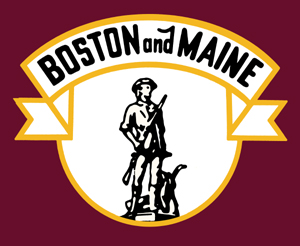
The Boston and Maine Railroad was a U.S. Class I railroad in northern New England. It was chartered in 1835, and became part of what was the Pan Am Railways network in 1983.

The St. Lawrence and Atlantic Railroad, known as St-Laurent et Atlantique Quebec in Canada, is a short-line railway operating between Portland, Maine, on the Atlantic Ocean, and Montreal, Quebec, on the St. Lawrence River. It crosses the Canada–US border at Norton, Vermont, and Stanhope, Quebec, and is owned by short-line operator Genesee & Wyoming.

The Downeaster is a 145-mile (233 km) passenger train service operated by Amtrak and managed by the Northern New England Passenger Rail Authority (NNEPRA), an agency of the state of Maine. Named for the Down East region of Maine, the train operates five daily round trips between North Station in Boston, Massachusetts, and Brunswick, Maine, with ten intermediate stops.

The Boston and Lowell Railroad was a railroad that operated in Massachusetts in the United States. It was one of the first railroads in North America and the first major one in the state. The line later operated as part of the Boston and Maine Railroad's Southern Division.

The Maine Central Railroad was a U. S. class 1 railroad in central and southern Maine. It was chartered in 1856 and began operations in 1862. By 1884, Maine Central was the longest railroad in New England. Maine Central had expanded to 1,358 miles (2,185 km) when the United States Railroad Administration assumed control in 1917. The main line extended from South Portland, Maine, east to the Canada–United States border with New Brunswick, and a Mountain Division extended west from Portland to St. Johnsbury, Vermont, and north into Quebec. The main line was double track from South Portland to Royal Junction, where it split into a "lower road" through Brunswick and Augusta and a "back road" through Lewiston, which converged at Waterville into single track to Bangor and points east. Branch lines served the industrial center of Rumford, a resort hotel on Moosehead Lake and coastal communities from Bath to Eastport.

The International Railway of Maine was a historic railroad constructed by the Canadian Pacific Railway (CPR) between Lac-Mégantic, Quebec, and Mattawamkeag, Maine, closing a key gap in the railway's transcontinental main line to the port of Saint John, New Brunswick.

Haverhill station is an intercity and regional rail station located in downtown Haverhill, Massachusetts, United States. It is served by Amtrak's Downeaster service and the MBTA Commuter Rail Haverhill/Reading Line; it is the northern terminus of MBTA service on the line. Haverhill is one of two major hubs for MVRTA local bus service; the Washington Square Transit Center is located 1⁄5 mile (0.3 km) east of the rail station.

Portland Transportation Center is a bus and train station in Portland, Maine, United States, served and run primarily by Concord Coach Lines and Amtrak Downeaster passenger trains. It is also served by Megabus, as well as the Greater Portland Metro route 1 and BREEZ bus services. The station is open from 4:30 AM to 12:15 AM and from 2:45 AM to 3:15 AM.
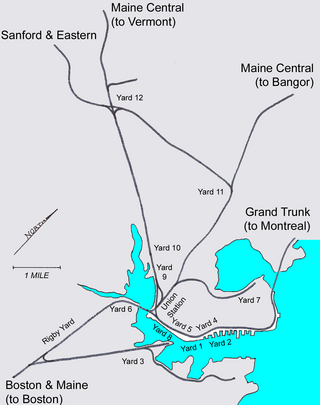
The Portland Terminal Company was a terminal railroad notable for its control of switching (shunting) activity for the Maine Central Railroad (MEC) and Boston & Maine (B&M) railroads in the Maine cities of Portland, South Portland, and Westbrook.

The Mountain Division is a railroad line that was once owned and operated by the Maine Central Railroad (MEC). It stretches from Portland, Maine on the Atlantic Ocean, through the Western Maine Mountains and White Mountains of New Hampshire, ending at St. Johnsbury, Vermont in the Northeast Kingdom. The line was abandoned in 1983 by MEC's successor, Guilford Transportation Industries (GTI). Guilford retained a stub between Portland and Westbrook. A section in New Hampshire remains in use by heritage railway Conway Scenic Railroad.

Maine Eastern Railroad was a railroad that operated in coastal Maine, between Brunswick and Rockland, on the former Maine Central Rockland Branch rail line. Maine Eastern passenger trains connected with the Amtrak Downeaster passenger train and Pan Am Railways at Brunswick Maine Street Station. The state of Maine did not renew the operating contract with MERR, which effectively ended operations at the end of 2015.

Brunswick Maine Street Station, or Brunswick station, is a multi-modal, multi-use real estate development in Brunswick, Maine. Located on Maine Street, it consists of commercial offices, service centers, healthcare, retail, restaurants, theater and residential space. Brunswick Station is also a transportation hub for city buses, taxis, and passenger trains.
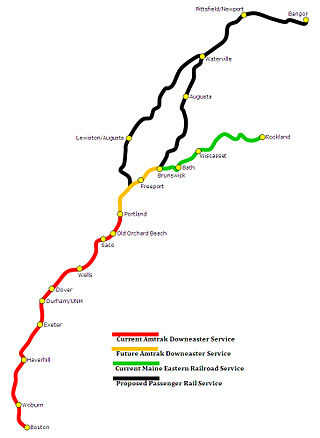
Trainriders Northeast is a non-profit citizens' organization group based out of Portland, Maine, in the United States. It was established in 1989 to advocate for the extension of passenger rail service from Boston to Portland and points north. Today Trainriders Northeast may be most well known for their role in bringing passenger service back to Portland, with the Amtrak Downeaster.
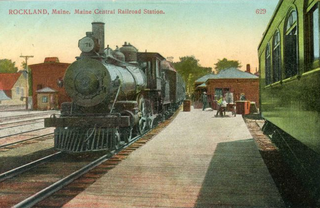
Rockland station is a railway station located at Union and Pleasant Streets in Rockland, Maine. It is the eastern terminus of the Rockland Branch, a state-owned track connecting Rockland and Brunswick. The historic station building was built in 1917 by the Maine Central Railroad, and was listed on the National Register of Historic Places in 1978 as Rockland Railroad Station. It presently houses a restaurant, and served for a time as Rockland's city hall. The line is presently inactive, having most recently had seasonal passenger service from 2004 to 2015 operated by the now-defunct Maine Eastern Railroad. The line would then be leased to the Central Maine and Quebec Railway (CMQ) from 2015 to 2020, then to Canadian Pacific Railway following its purchase of CMQ in 2020. CMQ originally planned to reintroduce service on the line, but not with excursions.
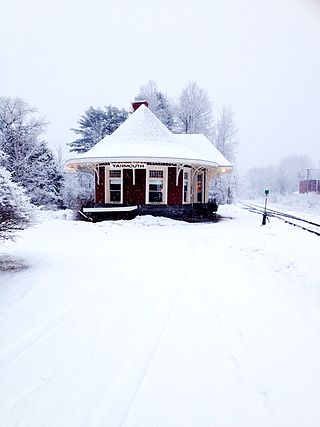
Yarmouth station of Yarmouth, Maine, is located on the east side of the railroad tracks, just south of Maine State Route 115, the town's Main Street. The railroad station was built in 1906 by the Grand Trunk Railroad, and is a well-preserved example of an early 20th-century passenger rail depot, an increasingly rare sight in the state. The building, which is now in commercial use, was added to the National Register of Historic Places on July 10, 1979.
The following is a timeline of the history of the city of Portland, Maine, USA.

The Maine Central Railroad Company main line extended from Portland, Maine, east to the Canada–US border with New Brunswick at the Saint Croix–Vanceboro Railway Bridge. It is the transportation artery linking Maine cities to the national railway network. Sections of the main line had been built by predecessor railroads consolidated as the Maine Central in 1862 and extended to the Canada–US border in 1882. Through the early 20th century, the main line was double track from South Portland to Royal Junction, where it split into a lower road through Brunswick and Augusta and a back road through Lewiston which converged at Waterville into single track to Bangor and points east. Westbound trains typically used the lower road with lighter grades, while eastbound trains of empty cars used the back road. This historical description does not include changes following purchase of the Maine Central Railroad by Guilford Transportation Industries in 1981 and subsequent operation as part of Pan Am Railways.

Union Station was a train station in the Libbytown neighborhood of Portland, Maine, which operated from 1888 to 1960. Located on St. John Street, it was demolished in 1961 and is now the site of a strip mall.

Railroads have played an important role in New England ever since the Granite Railway, America's first commercial railway, began operations in Massachusetts in 1826. As industrialization spread across the region, hundreds of railroads were built throughout the 19th century. Railroad mileage peaked around World War I, and from that point on mileage began to shrink. Despite this, railroads continue to be important for freight and passenger transportation in the region, with the New Haven Line holding the title of busiest railroad line in the entire United States.
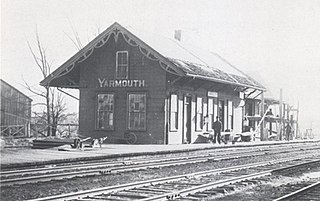
Yarmouth Junction station was a passenger rail station in Yarmouth, Maine, United States. It stood to the west of East Elm Street at Depot Road, at the junction of the former Grand Trunk Railway and the Maine Central Railroad, around 0.9 miles (1.4 km) north of the town's Railroad Square, where today's 1906-built Grand Trunk station stands. The Amtrak Downeaster utilizes the former Maine Central Railroad line, which passes to the northwest of town. The Yarmouth Junction station building is now gone, but the junction itself is still active.




























